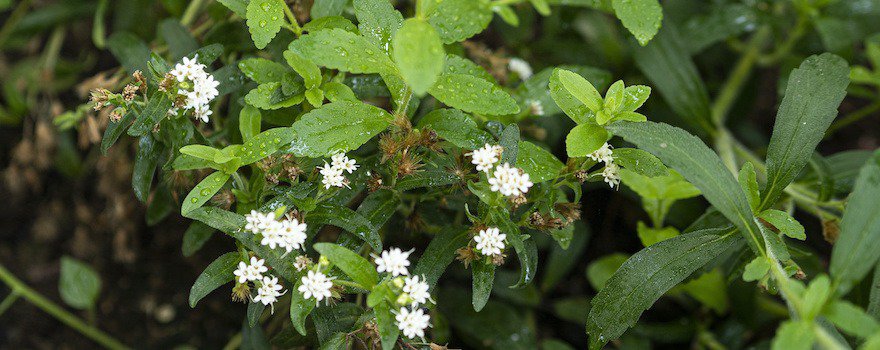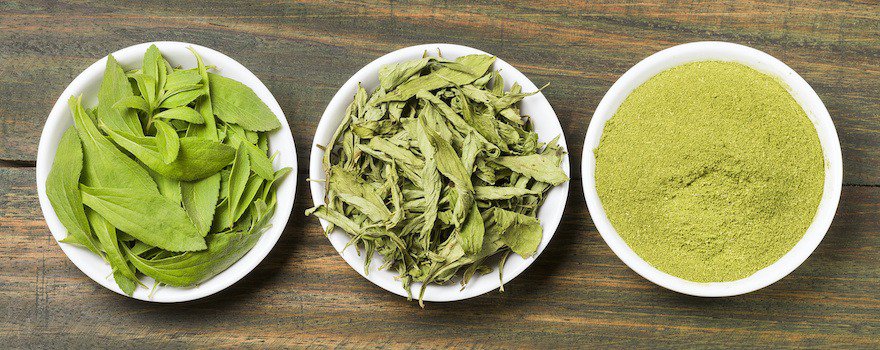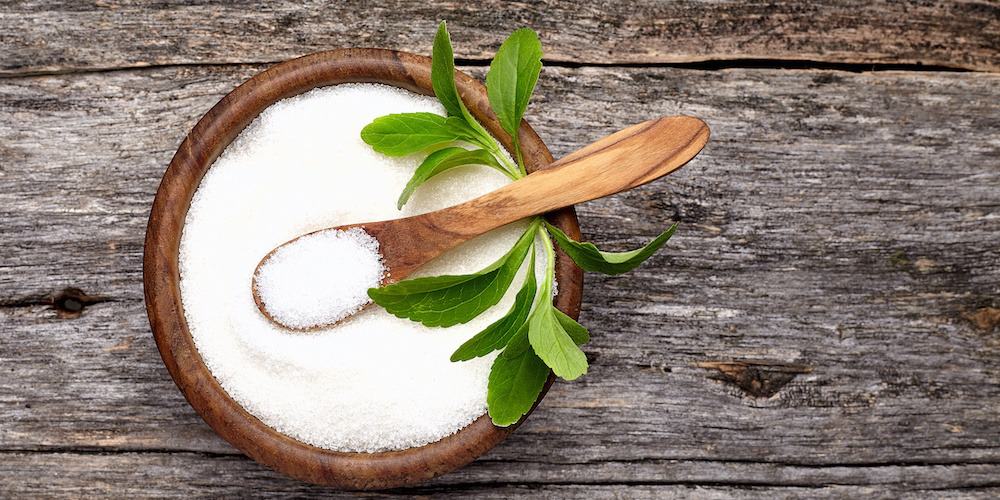BENEFITS OF STEVIA
✓ Reduces blood pressure
✓ Helps with diabetes
✓ Fights bacteria
✓ Anti-inflammatory
✓ May help you stay in shape
What is stevia?
Stevia, whose scientific name is Stevia rebaudiana, is a plant belonging to the Asteraceae family, like chicory or yarrow (yarrow). Native to South America, it grows naturally in high-altitude regions, between 500 and 1,500 m. It is most commonly found in Paraguay, Bolivia, Argentina and Brazil, which it favors for its humid but sunny climate.
Like agave, stevia has been valued and used for centuries for its sweetening power, which is far greater than that of sucrose (white sugar).
This quality is due to steviol glycosides or steviosides, natural sweeteners present in its leaves. Thus, in pre-Columbian times, stevia was already used by the Guarani Indians to sweeten and soften their bitter drinks such as yerba mate.
It was not until the 16th century that it became the subject of research that then highlighted its sweetening properties. Gradually, it established itself around the world as a natural alternative to white sugar. But its leaves are also notable for an exceptional composition. Indeed, they contain vitamins, amino acids, minerals and trace elements, and fatty acids.
Numerous studies show that stevia helps reduce blood pressure, helps improve diabetes and fights certain pathogenic bacteria. It is also anti-inflammatory and helps with weight loss.
This plant remained banned in the United States for a long time. And for good reason: it directly competed with aspartame, a sweetener used by most major international firms. But some of them ended up using it, as a replacement for aspartame and saccharin. This is notably the case of Coca-Cola and Danone, wishing to offer a range of reduced-sugar products.
Nutritional composition
- Acides aminés
- Vitamines : A, B1, B3, C
- Minéraux et oligo-éléments : fer, calcium, zinc, magnésium, potassium, sodium
- Lipides
- Protéines
- Fibres
- Glucides
- Glycosides : stéviosides, rébaudioside, rubusoside, dulcoside A, stéviolbioside
- Acides gras : acide palmitique, palmitoléique, stéarique, oléique, linoléique, linolénique

The benefits of stevia
🌡 Reduces blood pressure
Consumption of stevia contributes beneficially to the regulation of blood pressure. The plant exerts hypotensive effects by promoting vasodilation and by inhibiting the activity of angiotensin II. This enzyme reduces the diameter of blood vessels, thereby causing an increase in blood pressure.
This action is believed to be due to the steviosides contained in the plant’s leaves. These sweet compounds reduce both systolic (maximum) and diastolic (minimum) blood pressure in hypertensive people.
This study from the National University of Asunción (Paraguay), conducted in men, shows how steviosides act on blood pressure.
🍭 Helps with diabetes
Stevia has several beneficial effects on diabetes. On the one hand, it does not cause blood sugar spikes after meals. Indeed, the carbohydrates resulting from its consumption are used by the microbiota and therefore do not enter the bloodstream.
On the other hand, the steviosides it contains lower blood sugar levels and stimulate insulin release. Like konjac, it also has the advantage of having a very low glycemic index since it is 0.
This study from Maharshi Dayanand Saraswati University (India), carried out in diabetic patients, shows how stevia improves diabetes.
🦠 Fights bacteria
Stevia has antibacterial properties and fights certain pathogenic bacteria. Thus, its glycosides slow their growth and their proliferation. In addition, they inhibit their hemolytic activity, that is, their ability to destroy red blood cells.
It has been shown to be particularly effective against the bacteria Escherichia coli, Salmonella typhimurium and Staphylococcus aureus. It also fights cariogenic bacteria, responsible for dental caries. Finally, it also appears to counter the development of the bacterium Borrelia burgdorferi, responsible for Lyme disease.
This study from the University of Latvia, conducted directly in the laboratory, shows the antibacterial action of stevia glycosides.
🔥 Anti-inflammatory
Stevia has anti-inflammatory effects and can notably reduce damage to the lungs and liver. It is also useful for arthritis, osteoarthritis, osteoporosis and chronic rheumatism.
On the one hand, its steviosides inhibit the NF-κB factor, a protein involved in the inflammatory response. On the other hand, they reduce tumor necrosis factor alpha (TNF-α) and the levels of pro-inflammatory interleukins 1 and 6.
This study from Harbin Medical University (China), conducted on mice, shows the anti-inflammatory action of stevia.
🏃🏻♂️ May help you stay in shape
Stevia is a valuable slimming ally when dieting. It doesn’t make you lose weight but helps you stay in shape and control your weight. Indeed, it can effectively replace refined white sugar without adding calories. Its caloric content is simply 0!
Moreover, it has a sweetening power up to 300 times greater than table sugar. This allows you to reduce your sucrose intake, a simple sugar involved in weight gain and obesity.
However, more studies are still needed to confirm stevia’s effect on weight loss.

How to consume stevia?
Stevia powder
Stevia is most often sold in powder form. Once harvested, the leaves are dried and then ground. They then undergo an extraction process to retain only the steviol glycosides, which will be purified shortly afterward.
Powder is a convenient and easy-to-use format for use in cooking to “sweeten” all kinds of preparations: cookies, cakes and pastries, beverages… It also has the advantage of being heat-stable up to 200°C. It has the same texture as sugar but is distinguished by an anise-like aftertaste, similar to licorice.
Dried stevia leaves
Dried stevia leaves are a minimally processed form. They can be used to prepare herbal teas and infusions with a licorice flavor. The resulting infusion can also be used to sweeten other drinks as well as sauces, soups, desserts…

Consume sustainably: favor local, organic, and fair-trade stevia
✓ China is the world’s leading producer of stevia and supplies 80% of production, or about 6,000 tonnes per year. This crop has also spread to North Africa, Australia, the United States and even Europe. In France, some farmers decide to try their hand at it as here in the southwest, a region well-suited to stevia cultivation.
✓ If possible, choose a stevia grown in France in organic farming and purified with water, without chemicals. During maceration and filtration processes, methanol or ethanol may be used by manufacturers. Also, in industrial products (sodas, etc.), it is not the whole plant that is used but a molecule from the plant.
✓ Fair supply chains are also beneficial for supporting the work of small stevia producers, for example in Brazil.
Dosage
The recommended dosage is 1 g of stevia per day.
Contraindications and side effects
Stevia consumption has certain contraindications :
- Par mesure de précaution, elle est déconseillée aux femmes enceintes et allaitantes et aux jeunes enfants ;
- Les personnes souffrant de diabète, d’hypertension ou d’hypotension doivent demander conseil à leur médecin avant d’en consommer ;
- Sa consommation peut interagir avec certains médicaments hypotenseurs ou hypoglycémiants.
Stevia consumption has very few side effects. Only an allergic reaction may occur in people sensitive to plants of the Asteraceae family.
If you experience side effects, stop taking it and consult a doctor.
Report by Julia Perez
Sources and scientific studies
Antonello Santini, Lydia Ferrara, Daniele Naviglio, A. Aragón, Alberto Ritieni, 2008. Stevia: Non caloric natural sweetener.
Luis A Barriocanal, Mafalda Palacios, Gilda Benitez, Sussam Benitez, Jorge T Jimenez, Nora Jimenez, Vicenta Rojas, 2008. Apparent lack of pharmacological effect of steviol glycosides used as sweeteners in humans. A pilot study of repeated exposures in some normotensive and hypotensive individuals and in Type 1 and Type 2 diabetics.
Mathur Rit, Johri Nandini, 2016. Nutritional composition of Stevia rebaudiana, a sweet herb, and its hypoglycaemic and hypolipidaemic effect on patients with non-insulin dependent diabetes mellitus.
I Deniņa, P Semjonovs, A Fomina, R Treimane, R Linde, 2014. The influence of stevia glycosides on the growth of Lactobacillus reuteri strains.
S K Goyal, Samsher, R K Goyal, 2010. Stevia (Stevia rebaudiana) a bio-sweetener: a review.



